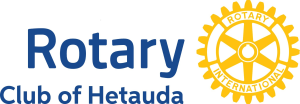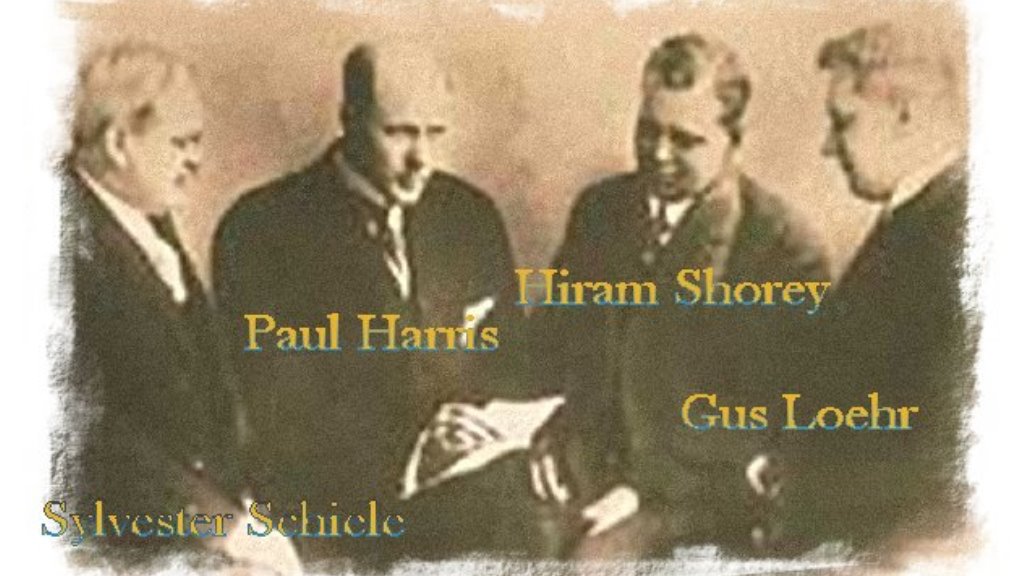A Brief History
The world’s first service club, the Rotary Club of Chicago, Illinois, USA, was formed on 23 February 1905 by Paul P. Harris, an attorney who wished to recapture in a professional club the same friendly spirit he had felt in the small towns of his youth. The name “Rotary” derived from the early practice of rotating meetings among members’ offices.
Rotary’s popularity spread throughout the United States in the decade that followed; clubs were chartered from San Francisco to New York. By 1921, Rotary clubs had been formed on six continents, and the organization adopted the name Rotary International a year later.
As Rotary grew, its mission expanded beyond serving the professional and social interests of club members. Rotarians began pooling their resources and contributing their talents to help serve communities in need. The organization’s dedication to this ideal is best expressed in its principal motto: Service Above Self. Rotary also later embraced a code of ethics, called The 4-Way Test, that has been translated into hundreds of languages.
During and after World War II, Rotarians became increasingly involved in promoting international understanding. In 1945, 49 Rotary members served in 29 delegations to the United Nations Charter Conference. Rotary still actively participates in UN conferences by sending observers to major meetings and promoting the United Nations in Rotary publications. Rotary Internationals relationship with the United Nations Educational, Scientific, and Cultural Organization (UNESCO) dates back to a 1943 London Rotary conference that promoted international cultural and educational exchanges. Attended by ministers of education and observers from around the world, and chaired by a past president of RI, the conference was an impetus to the establishment of UNESCO in 1946.
An endowment fund, set up by Rotarians in 1917 “for doing good in the world”, became a not-for-profit corporation known as The Rotary Foundation in 1928. Upon the death of Paul Harris in 1947, an outpouring of Rotarian donations made in his honor, totaling US$2 million, launched the Foundation’s first program – graduate fellowships, now called Ambassadorial Scholarships. Today, contributions to The Rotary Foundation total more than US$80 million annually and support a wide range of humanitarian grants and educational programs that enable Rotarians to bring hope and promote international understanding throughout the world.
In 1985, Rotary made a historic commitment to immunize all of the world’s children against polio. Working in partnership with nongovernmental organizations and national governments thorough its PolioPlus program, Rotary is the largest private-sector contributor to the global polio eradication campaign. Rotarians have mobilized hundreds of thousands of PolioPlus volunteers and have immunized more than one billion children worldwide. Rotary has contributed more than US$600 million to the polio eradication activities in 122 countries.
As it approached the dawn of the 21st century, Rotary worked to meet the changing needs of society, expanding its service effort to address such pressing issues as environmental degradation, illiteracy, world hunger, and children at risk. The organization admitted women for the first time (worldwide) in 1989 and claims more than 145,000 women in its ranks today. Following the collapse of the Berlin Wall and the dissolution of the Soviet Union, Rotary clubs were formed or re-established throughout Central and Eastern Europe. Today, 1.2 million Rotarians belong to some 33,000 Rotary clubs in more than 200 countries and geographical areas.
Founder of Rotary
Paul Percy Harris was a Chicago, Illinois, attorney best known for founding Rotary International in 1905, a service organization that currently has well over one million members worldwide.
Born: April 19, 1868, Racine
Died: January 27, 1947
Education: University of Iowa, Princeton University
History
The world’s first service club, the Rotary Club of Chicago, was formed on 23 February 1905 by Paul P. Harris, an attorney who wished to capture in a professional club the same friendly spirit he had felt in the small towns of his youth. The Rotary name derived from the early practice of rotating meetings among members’ offices.
Rotary’s popularity spread, and within a decade, clubs were chartered from San Francisco to New York to Winnipeg, Canada. By 1921, Rotary clubs had been formed on six continents. The organization adopted the Rotary International name a year later.
As Rotary grew, its mission expanded beyond serving club members’ professional and social interests. Rotarians began pooling their resources and contributing their talents to help serve communities in need. The organization’s dedication to this ideal is best expressed in its motto: Service Above Self.
By July 1925, Rotary had grown to more than 2,000 clubs and an estimated 108,000 members. The organization’s distinguished reputation attracted presidents, prime ministers, and a host of other luminaries to its ranks – among them author Thomas Mann, diplomat Carlos P. Romulo, humanitarian Albert Schweitzer, and composer Jean Sibelius.
The Four-Way Test
In 1932, Rotarian Herbert J. Taylor created The Four-Way Test, a code of ethics adopted by Rotary 11 years later. The test, which has been translated into more than 100 languages, asks the following questions:
Of the things we think, say or do
Is it the TRUTH?
Is it FAIR to all concerned?
Will it build GOODWILL and BETTER FRIENDSHIPS?
Will it be BENEFICIAL to all concerned?
Rotary and World War II
During World War II, many clubs were forced to disband, while others stepped up their service efforts to provide emergency relief to victims of the war. In 1942, looking ahead to the postwar era, Rotarians called for a conference to promote international educational and cultural exchanges. This event inspired the founding of UNESCO.
In 1945, 49 Rotary club members served in 29 delegations to the UN Charter Conference. Rotary still actively participates in UN conferences by sending observers to major meetings and covering the United Nations in its publications.
“Few there are who do not recognize the good work which is done by Rotary clubs throughout the free world”, former Prime Minister Winston Churchill of Great Britain once declared.
Dawn of a new century
As it approached the 21st century, Rotary worked to meet society’s changing needs, expanding its service efforts to address such pressing issues as environmental degradation, illiteracy, world hunger, and children at risk.
In 1989, the organization voted to admit women into clubs worldwide. Today, women are an integral part of Rotary’s membership.
After the collapse of the Berlin Wall and the dissolution of the Soviet Union, Rotary clubs were formed or re-established throughout Central and Eastern Europe. The first Russian Rotary club was chartered in 1990, and the organization underwent a growth spurt for the next several years.
More than a century after Paul Harris and his colleagues chartered the club that eventually led to Rotary International, Rotarians continue to take pride in their history. In honor of that first club, Rotarians have preserved its original meeting place, Room 711 in Chicago’s Unity Building, by re-creating the office as it existed in 1905. For several years, the Paul Harris 711 Club maintained the room as a shrine for visiting Rotarians. In 1989, when the building was scheduled to be demolished, the club carefully dismantled the office and salvaged the interior, including doors and radiators. In 1993, the RI Board of Directors set aside a permanent home for the restored Room 711 on the 16th floor of RI World Headquarters in nearby Evanston.
Today, 1.2 million Rotarians belong to over 32,000 Rotary clubs in more than 200 countries and geographical areas.


